 The latest numbers from the federal government shows biodiesel was the leader in growth among biofuels in the United States. The National Renewable Energy Laboratory’s (NREL) 2013 Renewable Energy Data Book showed good gains for many of the renewable energy industries, while energy consumption from petroleum actually slumped, despite an overall increase in the amount of energy consumed.
The latest numbers from the federal government shows biodiesel was the leader in growth among biofuels in the United States. The National Renewable Energy Laboratory’s (NREL) 2013 Renewable Energy Data Book showed good gains for many of the renewable energy industries, while energy consumption from petroleum actually slumped, despite an overall increase in the amount of energy consumed.
United States overall energy consumption grew to 97.3 quadrillion Btu in 2013, a 2.4% increase from 2012. Energy consumption from coal and renewables grew slightly, while consumption from petroleum and natural gas fell slightly.
Biodiesel was the fastest growing biofuel type, with production increasing by 64% in the United States and 17% globally, from a relatively small base.
Renewable electricity [including hydropower and biopower] grew to nearly 15% of total installed capacity and 13% of total electricity generation in the United States in 2013. Installed renewable electricity capacity exceeded 171 gigawatts (GW) in 2013, generating 534 TWh.
[S]olar electricity was the fastest growing electricity generation technology, with cumulative installed capacity increasing by nearly 66% from the previous year. [W]ind electricity generation increased 20% in 2013, while wind electricity capacity grew 1.8%.The report also found that in 2013, renewable electricity accounted for more than 61 percent of all new electricity capacity installations in the United States. By comparison, renewable electricity captured 4 percent of new capacity additions in 2004 and 57 percent in 2008.
Globally, solar photovoltaics (PV) and concentrated solar power (CSP) are among the fastest growing renewable electricity technologies— between 2000 and 2013, solar electricity generation worldwide increased by a factor of nearly 68.










